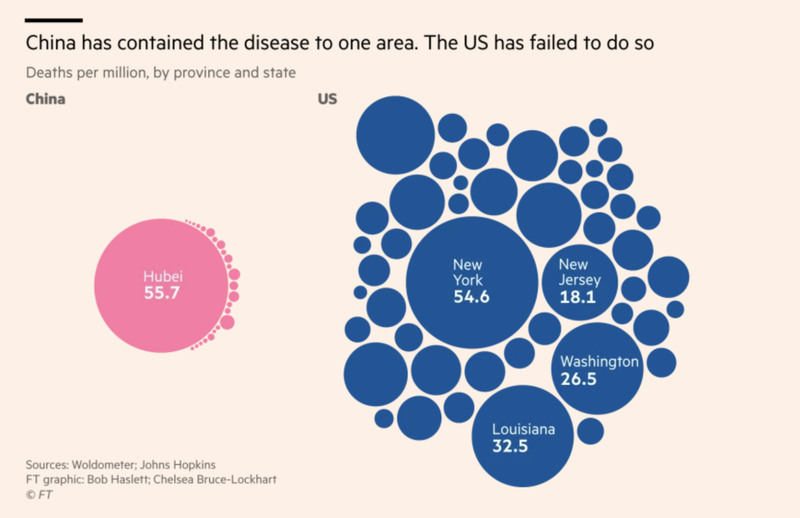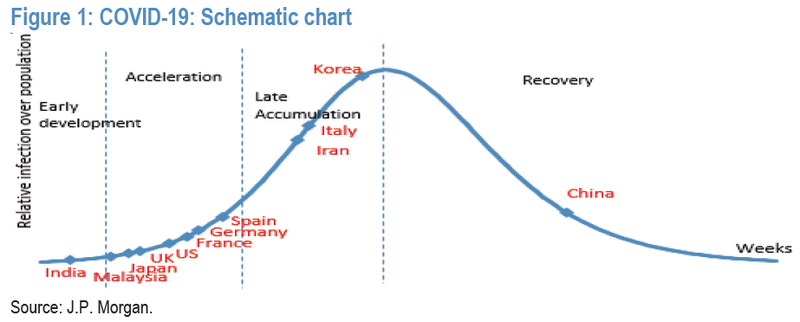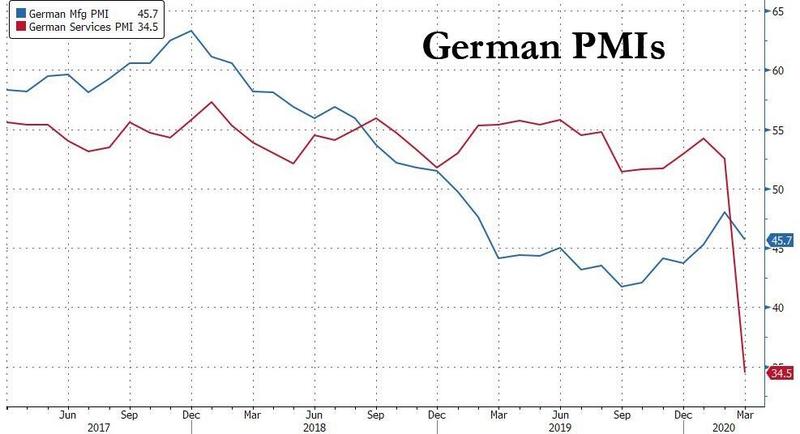The
CDC is now issuing travel alerts for U.S. states. These are not comparable to those already issued for countries. Recall that the CDC uses a 3 level warning system for countries. If it helps any with interpretation, the CDC site prominently features the color yellow when discussing New York, Connecticut, and New Jersey.
CDC is also considering making a recommendation within 10 days that all American wear the masks we don't have outside the home.
Pregnant? Plan on delivering without your spouse or a doula in the room. That's becoming standard across the country.
*****************************************
It seems like every story we here out of China starts out as an ugly rumor but ends up slowly being revealed as true. Recall that the official death toll in Wuhan is about 2,500. On February 14th I
posted a calculation based on numbers from early February that 30 is normal daily business at a crematorium in Wuhan, that they were doing about 100 extra every day, and that there were 7 crematoria in the city.
Now, I do believe that China has its outbreak mostly under control, what I don't believe is the rate at which they claim to have done it, or the total numbers.
That crematorium data is consistent with about 5K deaths per week. And it was based on interviews conducted 10 days after quarantine was announced. More than a couple of weeks of that peak rate seems reasonable, followed by several weeks of it slowly declining towards zero. We're now 9 weeks from the quarantine. Just to speculate, perhaps the numbers looked like this: 5,5,5,5,5,4,3,2,1 in which case we'd get 35K deaths. Or maybe 5,5,4,4,3,3,2,2,1 in which case we'd end up with 29K deaths. Whatever, I'm just trying to get some number sense here.
Both of those are way below what would be implied if the numbers
posted 3 times by Tencent in late January were actually a leak of the truth.
Now there are 3 new pieces of information that tend to confirm claims in this range.
Caixin, an investigative magazine based in Beijing reported speaking to truck drivers delivering memorial urns to crematoria in Wuhan after the ban on travel into Wuhan was lifted last week. The trucks carry 2,500 urns, and the driver had made a delivery the same size to the same crematorium the day before. Note from the number above that if there had been a lockdown but no increased deaths a single crematorium would be expected to need a delivery of just 1,800 urns to cover the entire period.
Caixin was also able to take a photo of 3,500 empty urns still stacked from deliveries inside the building. Both of these numbers are in the range of the 5K per crematoria calculation made above. Lastly, residents of Wuhan with green QR codes on their quarantine app are now permitted to pick up remains of family members at crematoria. The on the ground and often English-language blog
shanghaist reports that the pickup rate is 500 per day at a single crematoria, and that a special pickup period has been announced that runs through April 4th. Again, if that is followed at all 7 crematoria, the back-of-the-envelope calculation is 40K urns to be collected. They also report that reporters who identified themselves as being from Bloomberg were unable to make contact with the crematoria.
And, of course, in any location, the number of urns is an underestimate of deaths. Urns and pickups are one way that crematoria pull in revenue. Sometimes families can't afford this, sometimes the family members also died, and sometimes people die without loved ones to gather their remains. And, no blame on the Chinese here at all, but just like Katrina or 9/11, I can imagine that some peoples' remains were incinerated before a positive ID was made.
Lastly, note that these huge numbers from a country with over 4 times the population of the U.S. are
still lower than the forecasts of deaths for the U.S. published on Thursday, and also proportionally lower than the current death tolls in Italy, a country with about 4% of China's population.
And, on a personal note, if you're you're interested in China (who isn't), and you're interested in macroeconomics (isn't everyone), you just get in the habit of doing this sort of digging to pin down the truth about what is going on there.
*****************************************
Now let's use our economist-brains to figure out how the Chinese situation is even worse.
It's readily apparent that China pretty much shut down half the country for over a month. In China, reducing the amount of labor used is an aggregate supply shock. In the U.S. we feel this as an aggregate supply shock as well when we have trouble obtaining goods made there. In the context of a principles-level macroeconomic model, the world supply curve (typically drawn as horizontal, since ever exporter is a price taker at the "world price") shifted up, which will tend to reduce our imports. As in:
(You can find a bazillion diagrams like this on the internet, but most of them are solutions to specific homework problems on places like Chegg). I liked this one because it was fairly clean. It's appropriate for the U.S. in this situation, our imports are the distance BC, and COVID-19 shifted "World Price" upwards.
How do the Chinese feel about that? No doubt badly. They need income just like everyone else, and when our imports go down so do their exports.
But it gets worse for China. That was the story for last month. The story for next month is that the demand from all of China's trading partners is going to shift left, because we've mostly shut down our economies now. So at the moment when China is trying to increase production, and shift "World Price" back down, Demand in the figure above is going to shift to the left. This will tend to keep our imports (and China's exports) down.
Astute students might also recognize that this is a similar explanation to why Germany could not recover quickly (and pay reparations) after World War I. Let's hope the world economy does better this time around. Here's Bloomberg with coverage.
*****************************************
But, let's go back to China bashing. There has been a worry for the last 2 months that the WHO is excessively supportive of the official tune played by Beijing, otherwise they'd get no cooperation at all. Check this out. Taiwan (which has effectively fought the outbreak), but is not a member of the WHO because China insists that after 71 years it is still a renegade province:
That's the number 2 guy in the WHO right now, badly ducking some straightforward questions. That does not bode well for the WHO as a definitive source on what happened in China.
BTW: now is the time when you need to start worrying about availability of food in the U.S. I don't expect it to be a disaster. But, what we experienced earlier this month was a demand shock to grocery stores. What's coming is a supply shock as food production sites have to shut down as workers become infected. Most of those sites are located in rural areas, like the "pig farm" in nearby Milford,
where the disease will be slow to strike.
Video also surfaced, taken yesterday, showing Tongji Hospital in Wuhan refusing to take a patient in need of a diabetes related amputation. On the other hand, Hankou Railway Station is definitely open and people are traveling into Wuhan, so that's good.
The National Restaurant Association reports that 3% of restaurants nationwide have elected to close for good rather than just until this blows over. CraftWorks, a restaurant holding company, has shut down completely and permanently. They did not have many locations in Utah: an Old Chicago in Logan, and a Gordon Biersch in Terminal 1 at the airport in SLC.
If interested,
click through to Open Table's ridiculously interesting graphics on their State of Industry site. Clearly, they have to do a lot of rounding, but they show restaurant bookings for in-location sit-down meals dropping rapidly from a year ago on the same day. For example, in Utah, the last up day for restaurants was March 6. From there they dropped steadily a few points every day until the Governor's initial announcement on March 12th, and then crashed to nothing by March 19th.
The CFO of a top 10 Wall Street investment bank (
Jefferies) had died. (I'm a little dubious of that ranking; so let's just say if this firm offered you a job you'd take it in a heartbeat).
Florida is stopping cars from entering from Louisiana (where the outbreak is worst). From personal experience, you can usually get from New Orleans to the beaches in the Florida panhandle without stopping for gas. I am not advocating for Trump to put in some sort of national travel ban. Having said that, in our federalized system, this is what states will do when they think the federal government is not doing enough. So I think it's disturbing, but probably needed.
Remember what I said in class that there just is not much capacity to store oil, and this makes crude oil price-elastic. Wyoming Asphalt Sour crude, a particularly poor grade used in making roads, actually had its price go negative about 10 days ago (-$0.19 per barrel). This means that producers are paying refiners to take the product of their hands. That shale oil from Alberta (another particularly poor grade) has traded as low as around $5 per barrel. Sweet crudes in the U.S. are trading in the high teens. OPEC countries, who still have some market power over some countries, are generally trading in the high 20's. In the oil industry, this is called contango (last seen in 2008); this is where it is profitable to load oil tankers, use them as floating storage tanks, and contract to sell that oil in the futures market months out. It is estimated that current worldwide oil production exceeds demand by 20%, and that we are weeks away from all oil storage facilities being full.
I don't generally watch Sunday morning news talk shows. But I'd swear by the videos I saw of Jake Tapper that he is no longer working in the studio. And university folks thought we were the only ones using Zoom.
Different places are using different things for temporary hospitals. India, which was long in denial about the outbreak, is using railroad cars. In March/April. In the tropics. It's about 2 months until the monsoon hits.
Russia is closing its border tomorrow, but more importantly will not be honoring previously issued visas. For a place like Russia, that will block foreign reporters, and help to clamp down on getting the truth out.
Italy has had 2 better days in a row again. Cases there are still rising, but no longer accelerating. Deaths are still accelerating, but the acceleration is no longer steady.
Remember triage? Remember federalism? Synthesize.† States are being proactive and putting in rules for healthcare institutions that permit triage. But, the civil rights division of the Department of Justice in D.C. is saying that violates federal law. May I suggest that if we'd figured out the state/federal conflict over medical marijuana, that we'd have a template for more serious issues when they came up.
† People often do not understand the definition of synthesize, so if I was unclear
you can look it up.
New York City is reporting the highest rate of 911 calls since 9/11 (no pun intended).
There actually was quite a lot of news out of Iran today, both official, dissident,
legacy media, and from the U.S. State Department. The official ones show government officials all wearing face masks. The dissident ones argue that the official announcement of an outbreak in mid-February was
delayed by over 2 weeks, and that
hospital staff interviewed on March 25th said they were in day 51 of dealing with patients. The Johns Hopkins dashboard puts Iran's deaths at 2,640, while dissidents say:
The dashboard says they have 38K cases. If that is scaled up by a factor of five as well, then Iran has more like 200K cases.
Interesting low-level science article from USAToday showing that there are
now 8 strains of SARS-CoV-2 in common circulation. It also notes that the virus mutates slowly (unlike, say, influenza). You all learn the basic language of genetics in school, that DNA is written in pairs of bases. The virus has 30K of those pairs, and only 11 have mutated in the last 3 months.
Interesting piece on how the CDC knew we did not have enough ventilators 15 years ago, and did something about it. But the project failed because of consolidation in the medical device industry. Fair enough. But zero mention was made that Obamacare came down hard on the medical device industry, and basically forced a cost-cutting consolidation 5-10 years ago. This is kind of irresponsible on the part of the articles authors; this effect was not a secret, and both political parties have attempted to address it.
Most of you have seen the Cheyenne Mountain bunker in movies like
Deep Impact or
Wargames. This is not about panic, this is
standard (but very rare) procedure: Homeland Security has moved a command team into the bunker in case command teams located outside the bunker become compromised.
Wildlife. I lived in New Orleans for 9 years. Not surprisingly — warmth, humidity, tourists, drunks, restaurants, cruise ships — it was rat heaven. Now that people are off the streets, the
rats are out in force. This is not an unsolvable problem, but it does point to what economists call unintended consequences. And FWIW, I saw a roadkill coyote in my neighborhood on Leigh Hill the other day, and I recommend if you're staying locally that you really watch out for deer after dark.
Half-a-dozen of the stars of
Contagion have produced
public service announcements about COVID-19.






